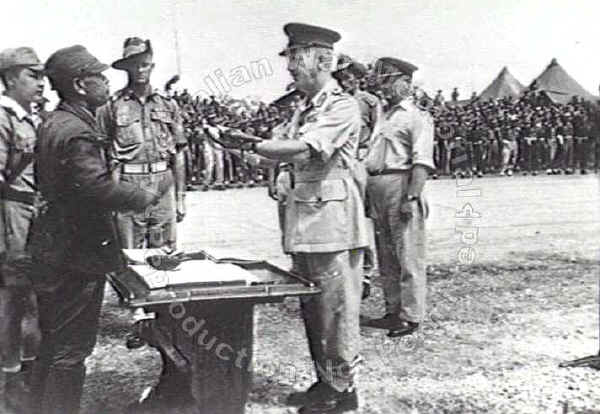
Posted on 08/04/2005 4:25:43 PM PDT by naturalman1975
THE grim-faced mystery soldier watching the Japanese surrender at Wom airstrip in New Guinea at the end of World War II has been identified.
He is Major Douglas Squire Irving Burrows, Deputy Assistant Adjutant General (senior administrative officer) of the Australian 6th Division.
His widow, Val Burrows, of Mosman in Sydney, said yesterday that Burrows had never spoken much about the war.
"He and his mates laughed about the funny things that happened - and their stories got better with the passing years - but they never spoke about the fighting," she said.
"There was no counselling in those days. The men just came back, got a job, and got on with life."
Ms Burrows said it was only last week, when she read Major General Paul Cullen's recollections in Paul Ham's recent book Kokoda, that she learned her husband had led two bayonet charges against Japanese positions.
Burrows enlisted in December 1939 and served in North Africa, Greece and New Guinea before finally managing to get out of the army in February 1946.
"He and a group of his friends were on the first boat out of the harbour, the P&O liner Orsova, at the start of the war. They were always very chuffed about being the first away," she said.
Like the rest of the 6th Division, Burrows was brought back from Greece by the government when Japan joined the war. He had eight days in Sydney before being shipped to New Guinea.
"We got married and then he was off to Kokoda," Ms Burrows said.
She had often seen the photograph of her husband that The Australian published on Tuesday, but the last time she visited the Australian War Memorial in Canberra it had been cropped so "only the side of his slouch hat" could be seen.
"I'm so glad it has been reproduced in full and that Doug has been identified," she said.
The search for the identity of the mystery soldier began when the photograph was featured on the front cover of the latest edition of Wartime, magazine of the Australian War Memorial.
The AWM asked if readers of The Australian could help identify the soldier, and yesterday a spokesman said they were delighted the search had been successful and that they could now fill in a piece of Australian history.
Doug Burrows's daughter, Tina Brauer, said her father's responsibility on September 13, 1945, was to orchestrate the ceremony.
"Thousands of Australian soldiers lined the airstrip and ordered arms for (commanding officer) General (H.C.H.) Robertson but were deliberately stood at ease and cheered when (Lieutenant-General Hatazo) Adachi and his surrender party were marched the entire length of the airstrip.
"Adachi surrendered his sword to General Robertson, but Adachi's aide surrendered his sword to Dad, and this sword is still held by the family."
After the war, Burrows became one of Sydney's leading stockbrokers. However, he is best remembered for his work over more than 15 years as chairman of Sydney's Royal Alexandra Children's Hospital board of management.
He died, aged 67, during a heart operation in 1982.
The Australian invites readers to describe their VP Day experiences. Photos are welcome. Contact us at nsw@theaustralian.com.au

Bump for a great post.
Two bayonet charges.. wow.. tough guy.. thanks for posting..
Another reporter proves he knows neither history nor how to use Google. Greece and Crete fell months before Japan attacked England and the Commonwealth, the US, and the Dutch.
So there were no Australian troops left in Greece to bring home by the time the Pacific war fired up. In fact, the war in Greece had been over for a good 6 months. (Greece - April - May 1941, Crete, May, 1941).
Until I read Touched With Fire: The Land War in the South Pacific I didn't know much about this theater of the war. The author says the cooperation was extremely good -- he says there were tighter links between the U.S. Army and Australian Army than there were between the U.S. Army and U.S. Navy.
Thanks for the clarification -- I wondered about that. I think I read that the Australians who were recalled toward home were mostly in North Africa (probably Egypt) at the time.
Thanks for your comments -- it's interesting to compare and contrast the way we fight and the way our friend and allies fight.
I just finished an amazing book by John Keegan, The Face of Battle. He described how officers in the British military by WWI often didn't carry a weapon and seemed to think that killing an enemy was a little bit below them. I figured that tradition was gone by WWII, but maybe it lived on awhile longer in the British military and other militaries (like Australia) that come from the British.
The folks who got evacuated from Greece and then Crete went to Alexandria, Egypt. They would have arrived there by June, 1941. I'm not sure when they sailed back for Australia.
Please FREEPMAIL me if you want on or off the
"Gods, Graves, Glyphs" PING list or GGG weekly digest
-- Archaeology/Anthropology/Ancient Cultures/Artifacts/Antiquities, etc.
Gods, Graves, Glyphs (alpha order)
Disclaimer: Opinions posted on Free Republic are those of the individual posters and do not necessarily represent the opinion of Free Republic or its management. All materials posted herein are protected by copyright law and the exemption for fair use of copyrighted works.